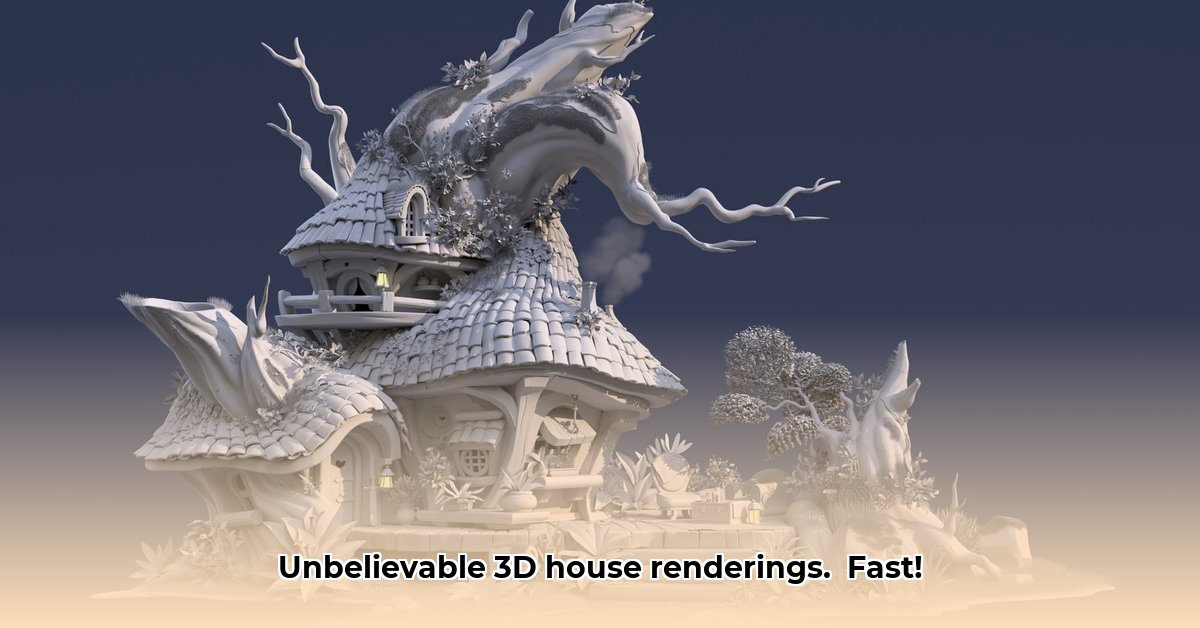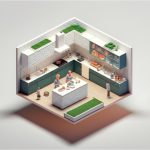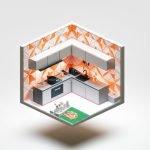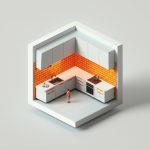Do you want to see your dream house before it’s built? High-quality 3D renderings are now essential for architects, developers, and homeowners to visualize and market projects. This guide covers everything about getting amazing 3D house renderings, from choosing the right company to understanding the process and setting a realistic budget. For additional planning tools, check out these online house planners. Let’s explore architectural design through cutting-edge technology!
Transform Your Vision into Reality with 3D House Rendering Services
Dreaming of showcasing your house design before construction begins? 3D house rendering services are the answer. They transform blueprints and sketches into realistic images, a game-changer for architects, real estate agents, and homeowners. Choosing the right service can feel overwhelming, so let’s explore architectural visualization, 3D modeling, and other crucial aspects.
1. Define Your Needs Before You Start
Before contacting a 3D rendering company, visualize your needs. Do you need exterior shots highlighting architectural details, detailed interior views showcasing kitchens and living spaces, or immersive virtual tours? Establishing your budget and deadlines is equally important. Providing more information upfront ensures a smoother 3D rendering process. Consider the following:
- Scope: Exterior, interior, or both?
- Detail Level: Basic visualization or photorealistic rendering?
- Specific Features: Landscaping, furniture, lighting?
- Resolution: What size and quality do you need for presentations or marketing?
2. Finding the Right Partner: Balancing Speed, Detail, and Cost
Choosing the right 3D rendering service is crucial. Some specialize in quick results, while others craft elaborate masterpieces. Some companies prioritize fast turnaround times and innovative technology, potentially sacrificing fine detail, while others meticulously focus on highly detailed and accurate representations, willing to invest more time and money.
Consider these factors when comparing providers:
- Portfolio: Review their past work to gauge quality and style.
- Testimonials: See what previous clients say about their experience.
- Communication: Ensure they are responsive and understand your vision.
- Technology: Do they use the latest software and techniques?
- Pricing Structure: Understand their pricing model and what’s included.
The best choice depends on your priorities. When on a tight deadline, prioritize speed. If precision and detail are paramount, be prepared to invest more time and money. Getting price quotes from several companies is advisable for budget comparison.
3. The Rendering Process: From Concept to Completion
The process of getting 3D house renderings typically involves these steps:
- The Initial Consultation: Discuss your project, needs, and budget. Provide blueprints, sketches, or CAD files.
- 3D Modeling: The rendering company constructs a 3D model based on your plans.
- Texturing and Lighting: The 3D model gets textures, lighting, and finishing touches to make it realistic. This includes virtual tour creation, if applicable.
- Review and Feedback: Review progress renderings and provide feedback. Good communication ensures you get what you envisioned.
- Revisions and Refinement: The rendering company incorporates your feedback and makes revisions.
- Final Delivery: Receive high-resolution images or a virtual walkthrough, ready for client presentations or marketing campaigns.
Open communication is crucial throughout. Setting realistic expectations about deadlines and the revision process prevents unexpected issues and ensures delivery satisfaction through iterative feedback cycles.
4. Beyond Still Images: Embrace Immersive Experiences
3D house renderings have advanced beyond simple images. Virtual reality tours of future homes are powerful for building excitement and emotional connections. Some companies also offer 3D printed models – tangible representations of your dream house for client examination. These enhance architectural visualization, making presentations unforgettable and boosting engagement. Explore these options to create a more engaging experience for your audience.
5. Understanding the Cost Factor: What to Expect
The price of 3D house rendering services varies. Simple exterior shots are cheaper than complex interior scenes with virtual tours and multiple revisions. Project complexity, the number of revisions, and the style chosen impact the final cost. Always get multiple quotes from different providers to compare pricing and services.
Factors influencing cost include:
- Project Size and Complexity: Larger, more detailed projects cost more.
- Level of Detail: Photorealistic renderings are more expensive than basic visualizations.
- Number of Revisions: More revisions mean higher costs.
- Turnaround Time: Rush jobs usually cost extra.
- Additional Services: VR tours, 3D printing, and animations add to the cost.
6. Selecting Your Style: Realistic or Artistic?
Do you need renderings that look like professional photographs, or a specific artistic interpretation? Photorealistic architectural renderings aim for a realistic look, showcasing project accuracy, while artistic renderings allow for creative expression, highlighting a certain mood. Communicate your preferred style to your service provider.
Consider these styles:
- Photorealistic: Mimics real-world photography, emphasizing accuracy.
- Artistic: Uses stylistic techniques to create a mood or impression.
- Conceptual: Focuses on conveying design ideas rather than realism.
7. Protecting Your Investment: The Importance of Contracts
Always have a signed contract with your selected provider to protect yourself and the service provider. The contract should clearly outline deliverables (number of renderings, file formats, and revisions), payment schedule, intellectual property rights, and data security. It ensures a smooth, legally sound collaboration and project success.
Key elements of a contract include:
- Scope of Work: Clearly define what’s included in the project.
- Timeline: Set deadlines for each stage of the project.
- Payment Terms: Specify payment schedule and methods.
- Copyright: Determine who owns the rights to the renderings.
- Confidentiality: Protect your project information.
Using professional 3D house rendering services transforms how you present architectural projects. By understanding your needs, carefully choosing a provider, and planning efficiently, you can create stunning visualizations that elevate your projects.
How to Choose Between Fast and High-Quality Architectural Visualization Services
Key Takeaways:
- Prioritize clear communication with potential providers to streamline project specifications and revisions.
- Thoroughly review portfolios and past projects for quality assurance, validating expertise and stylistic alignment.
- Understand the trade-off between speed and quality, balancing turnaround time against the level of detail.
- Define your budget and timeline upfront to avoid scope creep and unexpected costs.
- Negotiate clear contracts outlining deliverables and intellectual property rights, safeguarding your investment.
Need amazing 3D house renderings? Architectural visualization is booming. But how do you choose the best service for your project? Let’s explore how to choose between fast and high-quality architectural visualization services.
1. Defining Your Needs
Before diving in, ask yourself:
- What kind of rendering do you need? Exterior shots? Interior views? Walkthrough videos? Each adds to the cost and time.
- What’s your budget? Be realistic. High-quality work comes with a price tag that is often proportional to the level of details.
- What’s your deadline? Rushing the process can compromise quality, especially in intricate designs.
This initial self-assessment is crucial; it guides you toward the right provider. Have a clear vision of what you want to achieve.
2. Selecting a Service Provider
This is where things get interesting. Fast services often cut corners, while high-quality studios take more time. It’s a balancing act between expedited production and refined artistry in architectural visualization.
Consider these factors:
- Portfolio: Does their work visually match your project’s style and showcase the techniques you admire? Closely examine their past work for realism, detail, and aesthetic appeal.
- Reviews: What do past clients say about their communication, delivery, and overall client experience? Look for reviews on independent platforms to get unbiased feedback.
- Technology: Familiarize yourself with the software they use (SketchUp, Lumion, V-Ray, etc.), understanding it’s essential to the rendering process. Ensure they have the latest tools and expertise.
- Communication: How responsive are they? Clear communication is essential throughout the process in meeting deadlines. Test their responsiveness by sending inquiries.
Choosing between a boutique studio known for meticulous detail and a larger firm offering quicker turnaround is a critical decision, shaping project workflow.
3. The Rendering Process: A Step-by-Step Guide
- Initial Consultation: Discuss your project’s vision and budgetary constraints. Clearly communicate your requirements and expectations.
- 3D Modeling: The foundation of your visualizations is built, requiring precision. Review the model regularly to ensure accuracy.
- Texturing & Lighting: Detailing adds realism and visual appeal. Pay attention to material selection and lighting effects.
- Rendering: The magic happens—your images or video are created. This step transforms the model into a visual representation.
- Revisions: Feedback is vital, expecting a few rounds of adjustments ensures satisfaction. Provide clear and concise feedback to guide revisions.
- Final Delivery: Receive your stunning renderings to showcase architectural intent. Ensure the final renderings meet your specifications.
Effective communication is key throughout, setting expectations early on about timelines and revisions.
4. Enhancing Engagement with Technology
Think beyond static images. VR walkthroughs immerse potential buyers,
- Backsplash For Cooktop: Stylish Ideas To Protect and Enhance - December 25, 2025
- Stove Backsplash Ideas: Find Your Perfect Kitchen Style - December 24, 2025
- Stovetop Backsplash Ideas: Stylish Protection for Your Kitchen Cooking Zone - December 23, 2025










